International Campaign to Save the Monuments of Nubia
The International Campaign to Save the Monuments of Nubia was the relocation of 22 monuments in Lower Nubia, in Southern Egypt and northern Sudan, between 1960 and 1980. The success of the project, in particular the creation of a coalition of 50 countries behind the project, led to the creation of the World Heritage Convention in 1972, and thus to the modern system of World Heritage Sites.[1]
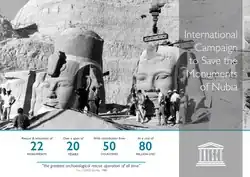 UNESCO brochure on the anniversary of the campaign | |
 The relocated monuments were from Lower Nubia, roughly between Aswan and Wadi Halfa. The area was entirely submerged by the creation of Lake Nasser | |
| Location | Aswan Governorate, Egypt |
|---|---|
| Region | Nubia |
| Official name | Nubian Monuments from Abu Simbel to Philae |
| Type | Cultural |
| Criteria | i, iii, vi |
| Designated | 1979 (3rd session) |
| Reference no. | 88 |
| Region | Arab States |
The project began as a result of the building of the Aswan Dam, at the Nile's first cataract (shallow rapids), a location which defined the traditional boundary of Ancient Egypt and Nubia. The building of the dam was to result in the creation of Lake Nasser, which would submerge the banks of the Nile along its entire 479 km (298 mi) length south of the dam – flooding the entire area of historical Lower Nubia. Vittorino Veronese, director general of UNESCO described it in 1960: "It is not easy to choose between a heritage of the past and the present well-being of a people, living in need in the shadow of one of history's most splendid legacies, it is not easy to choose between temples and crops."[2]
It was described in the UNESCO Courier as "the greatest archaeological rescue operation of all time".[3]
In April 1979, the monuments were inscribed on the World Heritage List as the Nubian Monuments from Abu Simbel to Philae, as one of the second group of properties added to the list (the first 12 had been added in 1978).[4]
Overview
In 1959, an international donations campaign was launched by Egypt and Sudan to save the monuments of Lower Nubia: the southernmost relics of the Ancient Egyptian civilization were under threat from the impending creation of Lake Nasser, that was about to result from the construction of the Aswan High Dam.[5]
Tharwat Okasha,[6] the Egyptian Minister of Culture, René Maheu, Assistant Director-General of UNESCO, and Christiane Desroches Noblecourt, French Egyptologist at the Louvre, had leading roles in the campaign.[7]
The number of relocated monuments have been stated as 22[8] or 24[9] depending on how an individual site is defined. Only one archaeological site in Lower Nubia, Qasr Ibrim, remains in its original location and above water; previously a cliff-top settlement, it was transformed into an island.[10][11] The relocated sites can be grouped as follows:
- Two temple groups moved nearby to nearly identical sites[9]
- Eleven temples rebuilt and grouped in three oases overlooking Lake Nasser[9]
- Seven temples placed in two museums[9]
- Five sent to Western museums as "grants-in-return" for technical and financial assistance[9]
The list of relocated monuments is as follows:
| Historical | Relocation | Current | |||||||
|---|---|---|---|---|---|---|---|---|---|
| Monument | Image[12] | Location | Period | Date | Led by | Image | Location | ||
| Abu Simbel (two temples) | 65m below current location | 13th century BCE | 1964–68 | Coalition | 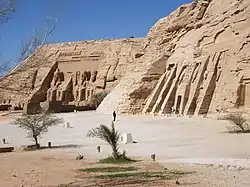 | 65m above historical location, in artificial hill | |||
| Philae temple complex | Philae Island | 300 BCE – 100 AD | 1972–79 | Coalition |  | Agilkia Island | |||
| Temple of Amada | Amada | 1400s BCE | France |  | New Amada | ||||
| Temple of Derr | ._Temple_dedicated_to_Pa_-_Horakhti.jpg.webp) | Derr | 1200s BCE | Egypt | _-_Egypt-9B-045_-_Temple_of_Derr_(Published_in_Wikipedia).jpg.webp) | ||||
| Tomb of Pennut at Aniba | _-_vue_ext%C3%A9rieure_du_tombeau_-_F%C3%A9lix_Teynard._LCCN2001695389_(cropped).jpg.webp) | Aniba | Egypt | .jpg.webp) | |||||
| Temple of Kalabsha (except gate, see below) | Kalabsha | 30 BCE | 1962–63 | Germany |  | New Kalabsha | |||
| Temple of Gerf Hussein | Gerf Hussein | 1200s BCE | Egypt |  | |||||
| Kiosk of Qertassi | Qertassi | 0 – 100 AD | 1960 | Egypt | 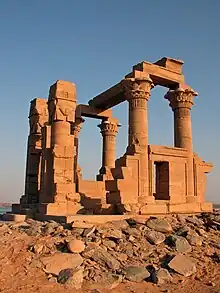 | ||||
| Temple of Beit el-Wali | _-_Google_Art_Project.jpg.webp) | Beit el-Wali | 1200s BCE | Egypt |  | ||||
| Temple of Dakka | Dakka | 200 BCE – 100 AD | Egypt | 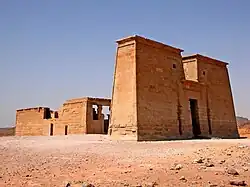 | New Wadi es-Sebua | ||||
| Temple of Maharraqa | Maharraqa | 0 – 100 AD | Egypt |  | |||||
| Temples of Wadi es-Sebua | Wadi es-Sebua | 1400–1200 BCE | Egypt |  | |||||
| Horemheb Temple at Abu Oda | 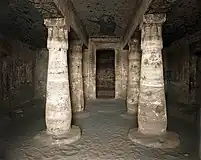
| Abu Oda | Nubian Museum, Aswan | ||||||
| Temple of Aksha | Aksha | 1200s BCE |  | National Museum of Sudan | |||||
| The temples in the fortified town of Buhen | .jpg.webp) | Buhen | 1800s BCE | _(33690109520).jpg.webp) | |||||
| The temples at Semna East and West fortresses | 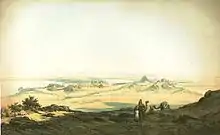 | Semna | 1900s BCE | 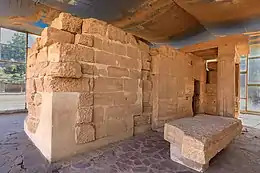 | |||||
| Temple of Debod | Debod | 100s BCE | 1960 | Spain | 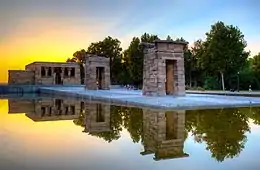 | Madrid, Spain | |||
| Temple of Dendur | Dendur | 23 BCE | United States | 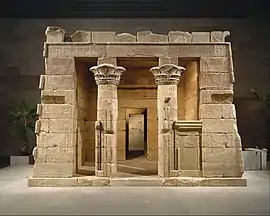 | Metropolitan Museum of Art, New York City, United States | ||||
| Temple of Taffeh | Taffeh | 25 BCE – 14 CE | 1960 | Netherlands | 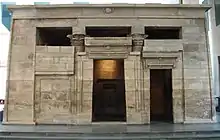 | Rijksmuseum van Oudheden, Leiden, the Netherlands | |||
| Temple of Ellesyia | Ellesyia | 1400s BCE | Italy |  | Museo Egizio, Turin, Italy | ||||
| Kalabsha Gate | Kalabsha | 30 BCE | 1962–63 | Germany | _(40205520311).jpg.webp) | Egyptian Museum of Berlin, Germany – part of the Temple of Kalabsha | |||
Historical images, monuments in situ
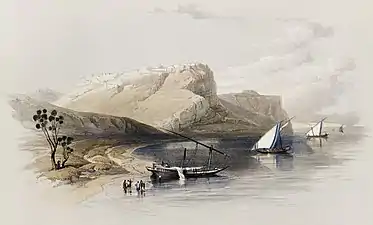 Qasr Ibrim (1840s)
Qasr Ibrim (1840s) Qasr Ibrim today
Qasr Ibrim today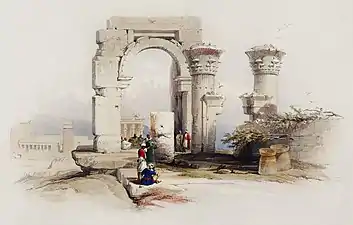 Ruins of Bigeh (1840s)
Ruins of Bigeh (1840s) Bigeh ruins today
Bigeh ruins today
Description and contributions
Abu Simbel

One scheme to save the Abu Simbel temples was based on an idea by William MacQuitty to build a clear freshwater dam around the temples, with the water inside kept at the same height as the Nile. There were to be underwater viewing chambers. In 1962 the idea was made into a proposal by architects Jane Drew and Maxwell Fry and civil engineer Ove Arup.[13] They considered that raising the temples ignored the effect of erosion of the sandstone by desert winds. However, the proposal, though acknowledged to be extremely elegant, was rejected.[14]
The salvage of the Abu Simbel temples began in 1964 by a multinational team of archeologists, engineers and skilled heavy equipment operators working together under the UNESCO banner; it cost some US$40 million (equivalent to $377 million in 2022). Between 1964 and 1968, the entire site was carefully cut into large blocks (up to 30 tons, averaging 20 tons), dismantled, lifted and reassembled in a new location 65 metres higher and 200 metres back from the river, in one of the greatest challenges of archaeological engineering in history.[15] Some structures were even saved from under the waters of Lake Nasser.[14]
Philae
_-_TIMEA.jpg.webp)
In 1902, the Aswan Low Dam was completed on the Nile River by the British. This threatened to submerge many ancient landmarks, including the temple complex of Philae. The height of the dam was raised twice, from 1907 to 1912 and from 1929 to 1934, and the island of Philae was nearly always flooded. In fact, the only times that the complex was not underwater was when the dam's sluices were open from July to October. During this period it was proposed that the temples be relocated, piece by piece, to nearby islands, such as Bigeh or Elephantine. However, the temples' foundations and other architectural supporting structures were strengthened instead. Although the buildings were physically secure, the island's attractive vegetation and the colors of the temples' reliefs were washed away. Also, the bricks of the Philae temples soon became encrusted with silt and other debris carried by the Nile. With each inundation the situation worsened and in the 1960s the island was submerged up to a third of the buildings all year round.[16]
The work began in 1972, and in 1974 a large coffer dam was built, constructed of two rows of steel plates between which a 1 million cubic metres (35 million cubic feet) of sand was tipped. Any water that seeped through was pumped away. Next the monuments were cleaned and measured, by using photogrammetry, a method that enables the exact reconstruction of the original size of the building blocks that were used by the ancients. Then every building was dismantled into about 40,000 units from 2 to 25 tons, and then transported to the nearby Island of Agilkia, situated on higher ground some 500 metres (1,600 ft) away. Foundations of the Philae monuments were ready on Agilkia by April 1977, and the transfer itself took place between 1977 and 1980.[17]
Individual Egyptian campaigns
In addition to participating directly in the high profile salvage operations of Abu Simbel and Philae, the Egyptian Antiquities Organization carried out the rescue of many smaller temples and monuments alone using their own financial and technical means.[18] As early as 1960 Egypt had started to rescue the temples of Taffeh (or Taffa), Debod and Qertassi, followed by Dakka and Maharraqa in 1961 and Dendur in 1962. The temples of Wadi es-Sebua and Beit el Wali and the rock tomb of Pennut at Aniba were moved in 1964 with the support of a US grant, whilst the subsequent re-erection was carried out with Egyptian resources. The Temple of Derr was rescued in 1965, and the temples of Gerf Husein, the chapel of Abu Oda (cut out of rock), the chapels of Qasr Ibrim (the rest of which has remained in situ), and many rock inscriptions and drawings, were also saved.[19]
West German operation at Kalabsha
Early in the campaign, the West German authorities offered to dismantle and re-erect the Temple of Kalabsha, the largest temple in all of Lower Nubia, with costs paid by West Germany.[20] Germany's interest in making a significant contribution stemmed from its Egyptological heritage, including Lepsius' milestone work Denkmäler aus Ägypten und Äthiopien, as more specifically the work of Franz Christian Gau who had documented Kalabsha as early as 1819.[21]
French operation at Amada
In addition to the work of French archaeologists at Abu Simbel, the French government provided significant technical and financial support for the removal of the Temple of Amada. Amada was considered "one of the most distinctive and best preserved examples of the art of the 18th dynasty."[22]
Wider archaeological campaign
Given the impending flooding of a wide area, Egypt and Sudan encouraged archaeological teams from across the world to carry out work as broadly as possible. Approximately 40 teams from across the world came to the region, to explore an area of approximately 500 km in length.[23]
In addition to the relocation operations, many countries participated in excavation and preservation work. Some of this work took place at the CEDAE (Centre d'Étude et de Documentation sur l'Ancienne Égypte, in English the Documentation and Study Centre for the History of the Art and Civilization of Ancient Egypt), founded in Cairo in 1955 to coordinate the academic efforts:[24]
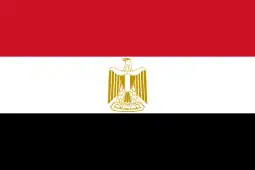 Egypt: Five campaigns by the University of Cairo at Aniba. One campaign by the University of Alexandria at Gebel Adda. Eight excavation campaigns by the Antiquities Service on various sites. Three campaigns by the Antiquities Service for cutting out rock drawings. Removal of eight monuments, work in two others, dismantling of the front part of the temple of Amada and financial contribution to the work for saving this temple and those of Wadi es-Sebua, Beit el-Wali and Aniba.[24]
Egypt: Five campaigns by the University of Cairo at Aniba. One campaign by the University of Alexandria at Gebel Adda. Eight excavation campaigns by the Antiquities Service on various sites. Three campaigns by the Antiquities Service for cutting out rock drawings. Removal of eight monuments, work in two others, dismantling of the front part of the temple of Amada and financial contribution to the work for saving this temple and those of Wadi es-Sebua, Beit el-Wali and Aniba.[24] Sudan: Since 1960, successive expeditions by the Antiquities Service, led by a Unesco expert, for a general survey of Sudanese Nubia; excavations at some of the most important sites.[24]
Sudan: Since 1960, successive expeditions by the Antiquities Service, led by a Unesco expert, for a general survey of Sudanese Nubia; excavations at some of the most important sites.[24] Argentina: Three archaeological campaigns in the Sudan by the National University of La Plata[24]
Argentina: Three archaeological campaigns in the Sudan by the National University of La Plata[24] Austria: Six archaeological campaigns in Egypt by the University of Vienna, in Egypt. Sending of an epigraphist to the CEDAE.[24]
Austria: Six archaeological campaigns in Egypt by the University of Vienna, in Egypt. Sending of an epigraphist to the CEDAE.[24].svg.png.webp) Belgium: Sending of three experts to the CEDAE. Photogrammetric and epigraphic records of five monuments in the Sudan. Contribution to the cost of transferring the temple of Semna, Sudan.[24]
Belgium: Sending of three experts to the CEDAE. Photogrammetric and epigraphic records of five monuments in the Sudan. Contribution to the cost of transferring the temple of Semna, Sudan.[24].svg.png.webp) Canada: One archaeological campaign in Egypt by the Royal Ontario Museum[24]
Canada: One archaeological campaign in Egypt by the Royal Ontario Museum[24] Czechoslovakia: Five expeditions in Egypt by the Institute of Classical Archaeology of Charles University[24]
Czechoslovakia: Five expeditions in Egypt by the Institute of Classical Archaeology of Charles University[24] Denmark,
Denmark,  Finland,
Finland,  Norway,
Norway,  Sweden: Four campaigns in Sudan by a joint mission. Finland alone: General surveying to the south of Gemai (near Wadi Halfa in Sudan).[24]
Sweden: Four campaigns in Sudan by a joint mission. Finland alone: General surveying to the south of Gemai (near Wadi Halfa in Sudan).[24] France: Six campaigns in Egypt by the Institut Français d'Archéologie Orientale. Two campaigns in Egypt by the University of Strasbourg. Photogrammetric study. Sending of nine experts to the CEDAE. Removal and reconstruction of the Temple of Amada, together with Egypt. Seven campaigns in Sudan by the Commission Nationale des Fouilles". Payment of the costs involved in transferring the temple of Aksha, Sudan[24]
France: Six campaigns in Egypt by the Institut Français d'Archéologie Orientale. Two campaigns in Egypt by the University of Strasbourg. Photogrammetric study. Sending of nine experts to the CEDAE. Removal and reconstruction of the Temple of Amada, together with Egypt. Seven campaigns in Sudan by the Commission Nationale des Fouilles". Payment of the costs involved in transferring the temple of Aksha, Sudan[24] West Germany: Three campaigns by the German Archaeological Institute[24]
West Germany: Three campaigns by the German Archaeological Institute[24] East Germany: Expeditions by the German National Academy of Sciences Leopoldina to record the rock inscriptions and drawings and the ground-plan of the ruins of Attiri, Sudan.[24]
East Germany: Expeditions by the German National Academy of Sciences Leopoldina to record the rock inscriptions and drawings and the ground-plan of the ruins of Attiri, Sudan.[24] Ghana: Three campaigns in the Sudan by the University of Ghana[24]
Ghana: Three campaigns in the Sudan by the University of Ghana[24] Hungary: One campaign in Egypt by Museum of Fine Arts (Budapest)[24]
Hungary: One campaign in Egypt by Museum of Fine Arts (Budapest)[24] India: One campaign in Egypt by the Archaeological Survey of India[24]
India: One campaign in Egypt by the Archaeological Survey of India[24] Italy: Six campaigns in Egypt by the University of Milan, as well as the sending of three experts to the CEDAE. One campaign in Egypt by the Sapienza University of Rome. Three campaigns in Egypt by Museo Egizio (Turin), including financial contribution from city and museum for cutting out of the chapel of the Temple of Ellesyia. Experimental work with sounding methods by the Fondazione Lerici.[24]
Italy: Six campaigns in Egypt by the University of Milan, as well as the sending of three experts to the CEDAE. One campaign in Egypt by the Sapienza University of Rome. Three campaigns in Egypt by Museo Egizio (Turin), including financial contribution from city and museum for cutting out of the chapel of the Temple of Ellesyia. Experimental work with sounding methods by the Fondazione Lerici.[24] Netherlands: Two campaigns by the National Museum of Antiquities, Leiden, in Egypt: excavations of Abdallah Nirqi (early Christian village, church with painted decoration) and of Shokan (late Meroitic village).[25] Preliminary studies for saving the Island of Philae. Contribution to the cost of saving the temple of Kumna (Sudan).[24]
Netherlands: Two campaigns by the National Museum of Antiquities, Leiden, in Egypt: excavations of Abdallah Nirqi (early Christian village, church with painted decoration) and of Shokan (late Meroitic village).[25] Preliminary studies for saving the Island of Philae. Contribution to the cost of saving the temple of Kumna (Sudan).[24] Poland: One campaign in Egypt and four in Sudan by the Polish Centre of Mediterranean Archaeology University of Warsaw. Sending of four architects to the CEDAE.[24]
Poland: One campaign in Egypt and four in Sudan by the Polish Centre of Mediterranean Archaeology University of Warsaw. Sending of four architects to the CEDAE.[24] Spain: Four excavation campaigns and four campaigns to record and cut out rock inscriptions, in Egypt. Three excavation campaigns, in the Sudan.[24]
Spain: Four excavation campaigns and four campaigns to record and cut out rock inscriptions, in Egypt. Three excavation campaigns, in the Sudan.[24].svg.png.webp) Switzerland: Two excavation campaigns in Egypt by the Schweizerisches Institut für Ägyptische Bauforschung und Altertumskunde in Kairo, one in co-operation with the University of Chicago, and one in co-operation with the Institut Français d'Archéologie Orientale. Architectural records of a temple and leadership of the Antiquities service expedition to cut out rock inscriptions in 1964. Sending of an expert to the CEDAE by the Swiss National Science Foundation.[24]
Switzerland: Two excavation campaigns in Egypt by the Schweizerisches Institut für Ägyptische Bauforschung und Altertumskunde in Kairo, one in co-operation with the University of Chicago, and one in co-operation with the Institut Français d'Archéologie Orientale. Architectural records of a temple and leadership of the Antiquities service expedition to cut out rock inscriptions in 1964. Sending of an expert to the CEDAE by the Swiss National Science Foundation.[24] United Kingdom: Four campaigns in Egypt and two in Sudan by the Egypt Exploration Society. Two campaigns by the Egypt Exploration Society and the University of London for the general survey of Nubia. Sending of two experts to the CEDAE. Sending of an epigraphist (in co-operation with Brown University). Contribution to the dismantling of the temple of Buhen.[24]
United Kingdom: Four campaigns in Egypt and two in Sudan by the Egypt Exploration Society. Two campaigns by the Egypt Exploration Society and the University of London for the general survey of Nubia. Sending of two experts to the CEDAE. Sending of an epigraphist (in co-operation with Brown University). Contribution to the dismantling of the temple of Buhen.[24] United States: In Egypt: Four campaigns by the University of Chicago in Egypt, including one in co-operation with the Swiss Institute of Architectural Research. Complete surveying and recording of a temple by the University of Chicago. Four campaigns by Yale and Pennsylvania Universities. Pre-history research on the Abu Simbel site by Columbia University. Four campaigns by Yale University. Sending of an epigraphist by Brown University (Provi-dence) in collaboration with the Egypt Exploration Society. Four campaigns by the Museum of New Mexico (pre-history survey). Four campaigns by the American Research Centre. Contribution by the United States Government for saving the temples of Beit el- Wali, Wadi es-Sebua and Aniba. In Sudan: Three excavation campaigns by the University of Chicago. One pre-history survey campaign by Columbia University. Three pre-history survey campaigns by the Museum of New Mexico. Two excavation campaigns and one architectural survey campaign by the University of California. Sending of an epigraphist by Brown University (Providence). Three pre-history investigation campaigns by the University of Colorado Museum. Contribution by the United States Government for the transfer and re-erection of the temple of Buhen.[24]
United States: In Egypt: Four campaigns by the University of Chicago in Egypt, including one in co-operation with the Swiss Institute of Architectural Research. Complete surveying and recording of a temple by the University of Chicago. Four campaigns by Yale and Pennsylvania Universities. Pre-history research on the Abu Simbel site by Columbia University. Four campaigns by Yale University. Sending of an epigraphist by Brown University (Provi-dence) in collaboration with the Egypt Exploration Society. Four campaigns by the Museum of New Mexico (pre-history survey). Four campaigns by the American Research Centre. Contribution by the United States Government for saving the temples of Beit el- Wali, Wadi es-Sebua and Aniba. In Sudan: Three excavation campaigns by the University of Chicago. One pre-history survey campaign by Columbia University. Three pre-history survey campaigns by the Museum of New Mexico. Two excavation campaigns and one architectural survey campaign by the University of California. Sending of an epigraphist by Brown University (Providence). Three pre-history investigation campaigns by the University of Colorado Museum. Contribution by the United States Government for the transfer and re-erection of the temple of Buhen.[24] Soviet Union: One survey and excavation campaign, in Egypt. General surveying and recording of rock inscriptions, in Egypt.[24]
Soviet Union: One survey and excavation campaign, in Egypt. General surveying and recording of rock inscriptions, in Egypt.[24].svg.png.webp) Yugoslavia: Sending of two architects to the CEDAE. Removal of Christian wall paintings (two experts), in Egypt. Removal of Christian wall paintings (two experts), in the Sudan.[24]
Yugoslavia: Sending of two architects to the CEDAE. Removal of Christian wall paintings (two experts), in Egypt. Removal of Christian wall paintings (two experts), in the Sudan.[24]
Financial contributions
The table below summarizes the contributions towards the project by the global coalition of nations. The vast majority of these contributions funded the operations at Abu Simbel and Philae.[26]
| Contributor | USD (thousands) | Notes |
|---|---|---|
| 2 | Government contribution | |
| 105 | ||
| 37 | ||
| 82 | ||
| 2 | ||
| 160 | ||
| 5 | ||
| 15 | ||
| 1,268 | ||
| 678 | ||
| 49 | ||
| 30 | ||
| 35 | ||
| 10 | ||
| 63 | ||
| 1,176 | ||
| 190 | ||
| 5 | ||
| 105 | ||
| 40 | ||
| 26 | ||
| 2 | ||
| 14 | ||
| 2 | ||
| 0.2 | ||
| 10 | ||
| 4 | ||
| 1 | ||
| 557 | ||
| 128 | ||
| 130 | ||
| 10 | ||
| 60 | ||
| 8 | ||
| 3 | ||
| 525 | ||
| 1 | ||
| 2 | ||
| 500 | ||
| 332 | ||
| 152 | ||
| 1 | ||
| 3 | ||
| 6 | ||
| 213 | ||
| 18,501 | ||
| 226 | ||
| 415 | ||
| 5 | ||
| Total Government contribution | 25,893 | |
| Miscellaneous private contributions | 36 | Private contributions |
| American Committee for the Preservation of Abu Simbel | 1,251 | |
| African Emergency Programme | 21 | |
| Belgium exhibition proceeds | 154 | |
| Canada exhibition proceeds | 4 | |
| France exhibition proceeds | 459 | |
| West Germany exhibition proceeds | 1,208 | |
| Japan exhibition proceeds | 1,089 | |
| Norway exhibition proceeds | 6 | |
| Sweden exhibition proceeds | 29 | |
| UK exhibition proceeds | 1,601 | |
| USSR exhibition proceeds | 1,602 | |
| 1 | ||
| Egypt Tourist Tax | 1,879 | Other Income |
| Interest and exchange adjustments | 1,408 | |
| World Food Programme | 3,518 | |
| Philatelic revenue and income from Philae Medals | 113 | |
| Grand total | 40,273 |
Timeline
A timeline of the key dates of the campaign is shown below:[27]
| Diplomacy | Relocation work | Aswan Dam | |
|---|---|---|---|
| 6 April 1959 | Egypt appeals to UNESCO | ||
| 24 October 1959 | Sudan appeals to UNESCO | ||
| 9 January 1960 | Work on the Aswan High Dam officially begun | ||
| 8 March 1960 | Director-General of Unesco appeals to the international community | ||
| Summer 1960 | Temples of Taffeh, Dabod and Kertassi dismantled by the Egyptian Antiquities Service | ||
| Nov. Dec. 1962 | Unesco's General Conference creates Executive Committee for the International Campaign | ||
| 1962–63 | Temple of Kalabsha dismantled, transferred and re-erected | ||
| Spring 1964 | Work begins on transfer of Abu Simbel temples | ||
| 14 May 1964 | Diversion of Nile to feed the turbines of the High Dam | ||
| September 1964 | Lake Nasser begins to fill | ||
| 22 September 1968 | Completion of the Abu Simbel operation | ||
| 6 November 1968 | UNESCO launches International Campaign to save the Temples of Philae | ||
| 1970 | Construction of Aswan High Dam completed | ||
| 1972 | Work begins on Philae rescue operation; monuments to be transferred to nearby island of Agilkia | ||
| May 1974 | Cofferdam around the island of Philae is completed and water is pumped out | ||
| April 1977 | Foundations of the Philae monuments ready on the island of Agilkia and reconstruction work begins | ||
| August 1979 | Completed at Agilkia | ||
| 10 March 1980 | Overall project completion |
World Heritage Site
In April 1979, the monuments were inscribed on the World Heritage List as the "Nubian Monuments from Abu Simbel to Philae". The inscribed area includes ten sites, five of which were relocated (all south of the city of Aswan), and five of which remain in their original position (near to the city of Aswan):[28]
Relocated sites, south of the Aswan Low Dam[28]
Sites in their original location, north of the Aswan Low Dam[28] – although these five sites are grouped within the "Nubian Monuments from Abu Simbel to Philae", they are neither Nubian, nor between Abu Simbel and Philae
- Qubbet el-Hawa (Old and Middle Kingdom Tombs)
- Ruins of town of Elephantine
- Stone quarries and Unfinished obelisk, Aswan
- Monastery of St. Simeon, Aswan
- Fatimid Cemetery of Aswan
Gallery
 Egyptian Government offer to gift monuments overseas in the 1960 UNESCO Courier
Egyptian Government offer to gift monuments overseas in the 1960 UNESCO Courier Egyptian and Sudanese declarations in the 1960 UNESCO Courier
Egyptian and Sudanese declarations in the 1960 UNESCO Courier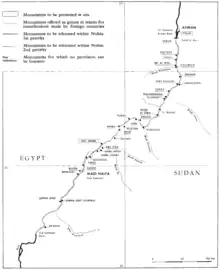 List of monuments at risk in the 1960 UNESCO Courier
List of monuments at risk in the 1960 UNESCO Courier List of monuments relocated in the 1980 UNESCO Courier
List of monuments relocated in the 1980 UNESCO Courier Philae Island in the 1961 UNESCO Courier
Philae Island in the 1961 UNESCO Courier List of sites excavated in addition to the monuments relocated in the 1980 UNESCO Courier
List of sites excavated in addition to the monuments relocated in the 1980 UNESCO Courier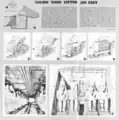 Abu Simbel in the 1961 UNESCO Courier
Abu Simbel in the 1961 UNESCO Courier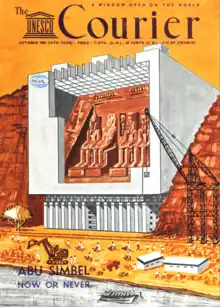 1961 UNESCO Courier
1961 UNESCO Courier List of Monuments to be Relocated in the 1961 UNESCO Courier
List of Monuments to be Relocated in the 1961 UNESCO Courier
Bibliography
UNESCO publications
- A Common trust: the preservation of the ancient monuments of Nubia, 1960, UNESCO CUA.60/D.22/A
- Save the treasures of Nubia: UNESCO launches a world appeal, 1960, UNESCO Courier
- Abu Simbel: now or never, 1961, UNESCO Courier
- Nubia's sands reveal their last secrets, 1964, UNESCO Courier
- Victory in Nubia: the greatest archaeological rescue operation of all time, 1980, UNESCO Courier
- Säve-Söderbergh, Torgny (1987). Temples and Tombs of Ancient Nubia: The International Rescue Campaign at Abu Simbel, Philae and Other Sites. Thames and Hudson. ISBN 978-92-3-102383-5. Retrieved 12 October 2022.
- Success stories, 2019, UNESCO
Other publications
- Desroches-Noblecourt, Christiane (1993). La Grande Nubiade ou Le parcours d'une égyptologue. Le Livre de poche (in French). Stock. ISBN 978-2-253-06366-7. Retrieved 11 November 2022.
- Larson, J.A. (2006). Lost Nubia: A Centennial Exhibit of Photographs from the 1905-1907 Egyptian Expedition of the University of Chicago (PDF). Oriental Institute Museum publications. Oriental Institute. ISBN 978-1-885923-45-5. Retrieved 11 November 2022.
- Zurinaga Fernández-Toribio, Salomé (6 January 2017). "Rescue Archaeology and Spanish Journalism: The Abu Simbel Operation". AP: Online Journal in Public Archaeology. JAS Arqueologia. 3: 46. doi:10.23914/ap.v3i0.29. ISSN 2171-6315.
- Allais, Lucia (2012). "The Design of the Nubian Desert: Monuments, Mobility, and the Space of Global Culture". Governing by Design: Architecture, Economy, and Politics in the Twentieth Century. The Aggregate Architectural History Collaborative. University of Pittsburgh Press. pp. 179ff. ISBN 978-0-8229-7789-6. Retrieved 12 October 2022. See also:
References
- The World Heritage Convention: "The event that aroused particular international concern was the decision to build the Aswan High Dam in Egypt, which would have flooded the valley containing the Abu Simbel temples, a treasure of ancient Egyptian civilization. In 1959, after an appeal from the governments of Egypt and Sudan, UNESCO launched an international safeguarding campaign. Archaeological research in the areas to be flooded was accelerated. Above all, the Abu Simbel and Philae temples were dismantled, moved to dry ground and reassembled. The campaign cost about US$80 million, half of which was donated by some 50 countries, showing the importance of solidarity and nations' shared responsibility in conserving outstanding cultural sites. Its success led to other safeguarding campaigns, such as saving Venice and its Lagoon (Italy) and the Archaeological Ruins at Moenjodaro (Pakistan), and restoring the Borobodur Temple Compounds (Indonesia). Consequently, UNESCO initiated, with the help of the International Council on Monuments and Sites (ICOMOS), the preparation of a draft convention on the protection of cultural heritage."
- A Common trust: the preservation of the ancient monuments of Nubia, 1960, UNESCO CUA.60/D.22/A, page 22
- Victory in Nubia: the greatest archaeological rescue operation of all time
- Meskell, L. (2018). A Future in Ruins: UNESCO, World Heritage, and the Dream of Peace. Oxford University Press. pp. 71–72. ISBN 978-0-19-064834-3. Retrieved 4 November 2022.
- Säve-Söderbergh 1987, p. 64.
- Sometimes spelled Saroite Okacha (in the French style of Arabic transliteration) in literature related to the International Nubian Campaign.
- Säve-Söderbergh 1987, p. 67.
- File:International Campaign to Save the Monuments of Nubia.pdf
- Allais 2012, p. 179.
- A.J. Clapham; P.A. Rowley-Conwy (2007). "New Discoveries at Qasr Ibrim". In R.T.J. Cappers (ed.). Fields of Change: Progress in African Archaeobotany. Groningen archaeological studies. David Brown Book Company. p. 157. ISBN 978-90-77922-30-9. Retrieved 5 November 2022.
... Qasr Ibrim is the only in situ site left in Lower Nubia since the flooding of the Nile valley
- Ruffini, G.R. (2012). Medieval Nubia: A Social and Economic History. Oxford University Press. ISBN 978-0-19-999620-9. Retrieved 5 November 2022.
Qasr Ibrim is critically important in a number of ways. It is the only site in Lower Nubia that remained above water after the completion of the Aswan high dam.
- The monuments of Nubia had been documented by early travellers and archaeologists, particularly in the 19th and early 20th centuries. Below are notable illustrations of the monuments published in the 1840s by David Roberts in his The Holy Land, Syria, Idumea, Arabia, Egypt, and Nubia
- Fry Drew Knight Creamer, 1978, London, Lund Humphries
- Säve-Söderbergh 1987, p. 98-126.
- Spencer, Terence (1966). The Race to Save Abu Simbel Is Won. Life magazine, 2 December 1966.
- Säve-Söderbergh 1987.
- Säve-Söderbergh 1987, p. 229-231.
- Säve-Söderbergh 1987, p. 135.
- Säve-Söderbergh 1987, p. 135-136.
- Stock, H.; Siegler, K.G. (1965). Kalabsha: der grösste Tempel Nubiens und das Abenteuer seiner Rettung (in German). F.A. Brockhaus. Retrieved 10 November 2022.
- Säve-Söderbergh 1987, p. 128-129.
- Säve-Söderbergh 1987, p. 132-133.
- Säve-Söderbergh 1987, p. 205.
- Säve-Söderbergh 1987, p. Annex I, page 223-226.
- Excavation Shokan. Research in Nubia from 1962 to 1964 on website rmo.nl. Retrieved 2023-08-23.
- Säve-Söderbergh 1987, p. Annex IV, page 232-233.
- Säve-Söderbergh 1987, p. 228-231.
- Centre, UNESCO World Heritage. "Nubian Monuments from Abu Simbel to Philae". UNESCO World Heritage Centre. Retrieved 12 October 2022.